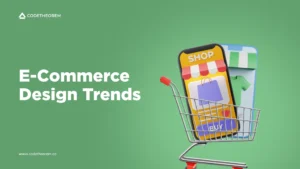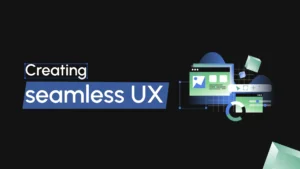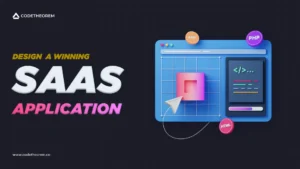Emotions play a big role in UX design. In fintech, several UX design best practices and challenges need to be taken care of. Here, every action the user takes matters to them. One wrong click can cost a lot. And as a designer, you cannot let that happen. Hence, a user-first fintech design is important. And with that, it has become a designer’s responsibility to make attractive UI designs and smooth UX. While there have been some emerging fintech trends going on for fintech UX design, there are still undiscovered opportunities for designers.
The fintech industry holds great potential to expand in the years to come. As we all know, managing finances is a huge task, and that is important too. Until now, the focus was on building secure and reliable apps to gain users’ trust. And the emerging focus is now making app and fintech website design more user-friendly than anything else!
What is fintech design?
Fintech is when you enable financial services for users with the help of technology. It is all about automating the delivery and use of financial services. Fintech is going to change the way you manage your finances.
The word “Fintech” is the portmanteau of the terms finance and technology. The most recent technological advances are applied to make financial activities more secure, approachable, and intuitive. Fintech apps are serving the interests of both your users and your business. The use of fintech apps has given rise to some note-worthy fintech UX design trends.
Fintech app design needs to be up-to-date with rising consumer needs. And a good fintech UI design is the right way to do it. Living for the sake of the moment. We’ve had enough of boring and monotonous bank trips. And now we all have started relying on apps that can ease the process for them.
While there are still so many opportunities available to elevate fintech UX design, here’s a list of 15 emerging fintech trends for UX design that prove the potential of fintech!
15 Emerging Fintech UX Design Trends for 2024
1. User-First Designs

There was a time when the company used to make decisions about the product’s packaging and had nothing to do with the users other than impressing them. And in today’s era,
“People ignore design that ignores people.”
The above line is as true as it gets. The ultimate stakeholder is the user. And if he is not satisfied with your financial products, you have done something wrong. Every design you see around you serves a function for its user. A user-first design may not always deliver a smooth UX because perfection is a myth. But if it is good enough to compete with its competitors, that shows that you have made something that streamlines the processes for the users.
When it comes to fintech, there are two options for building a fintech system:
- A user-first design
- Choose option 1
When fintech entered our lives, design was not the major focus. Certainly, Most of them have been feature-focused. And that is why they seem so plain. But not anymore; this year is going to be all about designing fintech that can deliver a smooth UX.
2. Biometric Technologies

Integrating biometric technologies into fintech UX designs is an intuitive trend. Imagine having to draw the security pattern or type the passcode every time you log on to an application or while making a payment. Won’t that be frustrating? Biometric technologies eliminate the problem by offering a unique solution. Now, users can unlock their Fintech application swiftly using a fingerprint sensor, voice recognition, or face recognition.
Biometric technologies are not only easy to access but also intuitive and inclusive. People with disabilities or elderly people can easily access the application without having to remember the passcode or the pattern. Biometric technologies give users a sense of security and control over the application.
3. Mobile Friendliness

We cannot deny the fact that every other person today owns a mobile phone. Firstly, everyone wants their work done at the top of their fingers, not standing in slow-moving queues at the bank.
Secondly, we all agree that we cannot perform any digital transaction without finances. And having a mobile application to manage your finances, investments, and trading accounts would be a blessing for all. Now this depicts the need for a seamless UX and elegant UI.
Social media and eCommerce are the most used apps of all. What if you couldn’t make online payments easily on the go? What if you don’t have any cash at hand and are to make the payment for your purchases?
It does sound scary! Well, Fintech Mobile apps have made it easy. The fintech industry has profusely moved towards adopting mobile apps. The huge user base of smartphones has increased the need for mobile-friendly fintech web design. A mobile-friendly design has become a necessity. Hence, this trend is topping the list of fintech UX design trends for 2024.
4. Fintech Going Social

Wouldn’t it be amazing if your fintech app were as easy as your social platforms? With a similar UI and UX pattern! Social fintech trends are an intersection of social and financial behavior patterns.
No doubt, we are addicted to social media. And this comes as a bonus point for designers. Social apps are user-focused, and taking some of their elements for a fintech design would get half of the work done. Also, it will help users easily navigate through the app.
An app designed similarly to social media platforms can turn out to be beneficial for users as well as the business. Above all, every good design is the outcome of thorough research work. When you create UX design for fintech apps inspired by social media platforms, make sure you don’t skip out on its purpose.
At the same time, there’s been a remarkable shift in how people see money and are open to discussing it within their circles. Even millennials and Gen Z are tweeting about their student loans and bragging about their success in stocks and crypto.
There have been oodles of customer retention and credibility observed towards the fintech app that allows users to split bills, recommend plans, help improve businesses, and acquire loans. All of this is the result of this new social behavior.
5. The future is AR/VR

We need to prepare for the revolution AR/VR will bring to the fintech industry. It carries great potential to enhance the UX of fintech. AR and VR technology entering the fintech and banking industries will help uncover the potential of mixed-world realities.
AR and VR have always been associated with the gaming industry. But they have made significant contributions to real estate, finance, and more. AR/VR technology has a wide range of apps when designing for fintech.
The need and demand for virtual operations have risen with AR technology. Certainly, the post-pandemic scenario has changed a lot in how banks operate and interact with their customers. Moreover, this fintech trend with AR and VR can aid in bridging that gap. It is still a fresh addition to the banking and fintech app design. But AR and VR will be behind creating the metaverse solutions in the banking sector. It still needs a lot of research and testing to build the best user experience possible.
When incorporating the fintech UX design trends of 2024, such as AR and VR, into fintech UX design, keep the following in mind:
- Don’t frustrate the user with information overload and try to keep it as simple as possible.
- Maintain consistency between AR and VR and the real world.
- AR/VR will transform the 2-D interface into a 3-D interface.
6. Microinteractions

Using Micro-interactions will help you to nullify the complexity of financial apps. Micro-interactions are like aiming for two targets with a single arrow. While they are fun and engaging elements for a fintech app, at the same time, they help reduce the data load on the application.
Fintech apps are heavy on data, notably in the backend. Hence, the micro-interactions allow for delivering feedback on users’ actions in a minimal and interesting way. They play an integral part in creating a good user experience. Some of the key benefits of using micro-interactions are as follows:
- Displaying the task status
- Communicating the brand message
- Prevent errors and mistakes from the users’ end
- It reduces the app loading time.
7. Artificial Intelligence

AI in fintech design focuses on providing a customer-centric experience. The AI assistance will help users take action without asking, improve their financial health, and make financial forecasts. At the same time, AI will enable financial institutions to monitor the financial health of customers and provide more suitable and individualized services.
Fintech apps are a set of multiple actions required from the users, the servers and the app itself. Since there’s plenty of data to be managed and processed, it is also important in UX design for fintech to get it done in a personalized and quick manner. This is crucial to building a competitive advantage as a brand. And to do that, AI is a huge help. The use of Artificial intelligence in financial apps has enabled them to deliver personalized experiences to users.
AI assists fintech app design with features like:
- Conversational interfaces, i.e., chatbots & digital assistants
- Natural language processing- (NLP)
- Fraud detection & data protection
- Accurate decision-making
- Process optimization
8. Gamification

Wondering how gamification can be on the list of fintech UX design trends in 2024? Certainly, the words gamification and finance don’t go together for us. But secretly, the elements of gamification have been infused with fintech here.
The word “gamification” may seem out of the ordinary here. So let us break the ice for you and show how beneficial gamification can be for UX design. Finance may not be the epitome of fun, but who said you couldn’t bring the fun to finance and stimulate healthy financial behavior.
Firstly, making impulsive decisions with fintech is one of the most common mistakes made by users. And to prevent that, why not infuse gamification with fintech? Gamification does not mean creating a game app. It simply means adding rewards, points, referral points, scoring, competitions, earning badges, etc. When you implement these elements correctly, it helps boost customer retention and loyalty.
Gamification eliminates the monotonous interface of the application. And this will create a more comfortable experience for the users. Ultimately, it aims to make financial matters less stressful. Gamification means making the design as user-centric as possible. A delightful user experience and secure transactions work as a competitive edge for you. Additionally, the loyalty and reward programs encourage users to make healthy financial decisions with your application.
9. Chatbot Features

Chatbots are yet another highly sought-after fintech UX trend. They are AI-based models that seamlessly use preset information to perform functions. Chatbots eliminate the conventional way of employing a person to attend calls and solve customer queries. They are a cost-effective and futuristic fintech feature.
Unlike humans, chatbots work 24/7 and carry out calls and queries perfectly. Imagine a user feeling lost while making a payment, and a chatbot with preset FAQs can quickly solve their confusion. This will make the users safe and secure. Making them feel valued and secure is crucial in a fintech application.
10. Voice User Interface

The voice user interface is a cutting-edge fintech UX feature that offers interaction with the application as we communicate with humans. On the base level, it is similar to voice assistants like Siri and Google Assistant, but the voice user interface goes a step further and facilitates communication better than any other voice assistant.
The voice user interface uses speech recognition, natural language processing, speech synthesis, and feedback. The fintech UX design is intended to enhance the user experience and make the fintech experience seamless and hassle-free.
11. Super Apps

A “super app” is an application offering a wide range of features in one. Initially, apps served mono-functionality; thus, they focused on one task only. But it would be difficult to use multiple apps for different tasks. Hence, having a single application that can do it all is no less than a boon.
Every other app you will come across is trying to turn into a super app. It helps with big data gathering, lowers developmental costs for the business, and ensures faster onboarding for the users.
While super apps are the need of the hour, at the same time, they need to be easy to use and user-friendly. Fintech super-apps should adhere closely to the brand’s values and mission. Our two cents on Super-Apps: make sure you start the project with a limited number of features and then gradually add more one by one. The modern and uplifting interface of fintech app design has created solutions that have stood out for their pleasant user experience.
12. Data Visualization

Every minute detail matters to the users when it comes to their financial transactions! The numbers in their pure form don’t make sense to us. Data helps to see and understand the patterns and UX trends going on. It is like an aggregation of financial data with charts and graphs. This will help the users understand the information in the simplest way possible.
Users are loyal to apps that can provide their data in the easiest way possible. Data visualization has now gone a step ahead, which is aggregating present and past financial actions. It provides insights into your choices with a predictive visualization.
Similar to the quantified self, where we do our self-tracking of the activities we do. For instance, we keep track of our walking steps or rides. Moreover, in such apps, we expect to see clear data visualization since the users are more used to seeing their data graphically.
13. Personalization

While all the fintech design trends revolve around users, personalization is equally important. Personalization has been at the forefront of marketing. It is the ideal way to deliver a pleasant user experience through your financial products. It makes your fintech product design more likable to users. The personalization in the UI of the fintech app is made with real-time user preferences and feedback. It is done to achieve the goal of building a positive experience of the product with users.
Credibility is an important factor when it comes to fintech. And personalization helps build trust in users of the app. Personalization is the fintech trend that helps add a personal touch similar to visiting the bank. You can easily notice the significant adoption of personalization in fintech apps and how businesses go out of their way with fintech UX design trends.
14. Human Language

One of the key reasons why people avoid using financial apps is the financial lingo. For building user-centric products, you need to know that people are scared of financial lingo. The users prefer clear and simple copies over anything else. Whatever is understandable is what works.
Clear and straightforward copies help create easy navigation through the fintech app and an intuitive experience. A financial app doesn’t need a difficult vocabulary. Traditional banking apps and Internet banking used to have difficult financial terminologies. And those were not favorable. However, the new-gen fintech applications use simple language that is understandable to the users at first glance.
15. Centralization

Several Fintech UX design trends for 2023 are making it to the top of the essential lists for apps. With the growing number of fintech app users, the designers focus on adding several features altogether.
A lot of fintech apps are built to bring all the essential features to one place. The worst part about feature-focused fintech apps is trying to fit the maximum number of details together. Bringing together so many features can confuse users. Certainly, fintech has made our lives easier. But it won’t be any easier if the long lists of features make the app slow and clumsy.
The use of third-party API is quite common in fintech apps. These third-party APIs provide the apps with features that would take time to build from scratch. It helps expand the portfolio of services in your Fintech. Some of the main domains like payments, security, analytics, account information, loyalty programs, etc. are added with third-party APIs.
To conclude,
The fintech industry is still undiscovered and full of potential. You can be a part of something revolutionary and start implementing these fintech trends in 2024. Code Theorem is a fintech design agency to help you design your fintech product from scratch or redesign your products with the newest UX trends in fintech or design from scratch.


















